We use cookies to ensure that we give you the best experience on our website. By continuing to use this site, you agree to our use of cookies in accordance with our Privacy Policy.
 Login
Login
Your Role
Challenges You Face
results
Learn
Resources
Company
The case for marketing automation: Why nonprofit fundraising operations should automate tasks to optimize staff performance


Fundraising is getting harder
You don’t just feel it. You know it from the data.
Retention is getting tougher. Attracting new donors is becoming more costly. The one bright spot of late has been that major gifts have increased, which has compensated for losses in other areas.
For now.
The question is, can this be sustained?
If you’re like most nonprofit leaders and fundraisers, you’re a bit worried that it can’t. To do fundraising well, it requires significant increases in staff, money, and time. In other words, all the things we never have enough of in nonprofit fundraising shops.
But now there’s this tool out there called marketing automation. You’ve probably heard of it. You may have even looked into it.
Marketing automation allows you to do more with less
When you hear about the broad benefits, it seems like the perfect solution to your problem of needing more of all the things you don’t have: time, money, and personnel.
Marketing automation leverages technology to speed up communication between your nonprofit and its current and potential donors while letting fewer people slip through the cracks. It also frees up staff time by liberating them from mundane tasks. And it reduces costs.
Put all this together, and marketing automation seems like the ticket for increasing your fundraising moves management efficiency and effectiveness without increasing costs or staff time.
It’s like Netflix compared to Blockbuster.
You do remember Blockbuster Video, right? If you’re under 30, go ask your parents about it. Blockbuster was the #1 video rental chain in the nation for many years.
They had over 9,000 stores, over $6 billion in revenue, and 85,000 employees at their peak in 2004.
Today, they have one store—in Bend, Oregon.
What happened?
Netflix happened.
By delivering a similar but more convenient, tech-enabled service at a far lower cost, Netflix obliterated Blockbuster. They did it because they were able to automate tasks that had to be done in person and in physical stores at Blockbuster.
As of 2021, Netflix generates over $20 billion in annual revenue, more than three times what Blockbuster made at their peak (not adjusting for inflation).
But here’s the most important comparison:
Netflix is generating more than three times the revenue with one-tenth the employees. They have 8,600 employees. Their revenue per employee is over $2.3 million, compared to about $70,000 for Blockbuster at its peak. That’s 32 times more revenue per employee! All this was made possible because Netflix leveraged technology to its advantage. And now, you can do that, too.
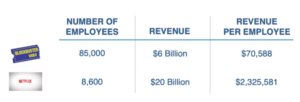
Netflix leveraged technology to generate over 32 times more revenue per employee than Blockbuster.
So what about nonprofits?
When you look at those numbers, maybe you wonder, as I did, why nonprofits can’t do something similar. Sure, we’re not renting movies or TV shows, but we are trying to communicate with a lot of people at one time using finite resources and personnel.
The problem is, when you look into marketing automation to optimize your fundraising operations, all you find are companies like Hubspot, Marketo and Pardot (part of Salesforce.com’s marketing bundle). They are great tools, but they require you to do all the work to populate them. That takes time and requires expertise. Both cost money.
Plus, they don’t really speak ‘nonprofit.’ That’s because their platforms are set up for for-profit businesses, not nonprofit ones.
They also don’t recognize the fact that you’re short on staff, your training budget is tiny or nonexistent, and your organization is likely to experience high rates of staff turnover, making training investments unprofitable.
In short, those programs know private sector business operations. They don’t know fundraising business operations like yours.
Private sector marketing automation platforms aren’t the right tool for the job.
Instead non-profits need fundraising automation because of how uniquely it gets applied to your context. Fundraising-oriented automated emails must look different from regular business automation emails, especially if your goal is to raise major gifts of assets, close legacy gifts or migrate mid-level donors up the pyramid.
In this post (and the next few that follow) I’ll show you how fundraising automation can not only improve your operations—especially with regards to its fundraising effectiveness—but how it can also help your staff be the fundraisers they always wanted to be. As a result, it will help you increase employee satisfaction, so staff stay put and the best in the field desperately want to work for you.
The urgency of leveraging fundraising automation
As you look at the data we’re about to reveal, you’ll understand why we call this fundraising climate change. It’s there, and if you don’t do something to stave it off, your organization could be forced to downsize, merge, or perhaps even shut down.
The data of fundraising climate change
When you look at nonprofit revenues these days, as we have, you’ll learn some startling facts.
- If your organization is like most, 67.28% of your revenue is coming from just .59% of your donors—the high-dollar donors.
- And even more extreme, on average, only 7.81% of nonprofit revenue comes from most (79.94%) of the donors—the low-dollar donors.
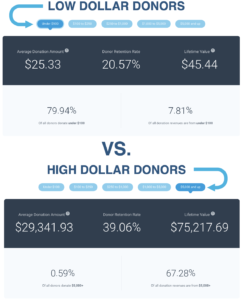
2020 metrics compiled from data submitted to the Fundraising Report Card by over 8,000 organizations and institutions. See how your metrics compare for free at www.fundraisingreportcard.com.
Don’t read over those numbers too fast. Look at them again.
More than 2/3 of your revenue is coming from about half of 1% of your donors!
Yet most nonprofits devote the vast majority of their fundraising budgets to reaching low-dollar donors. They got addicted to acquisition, but dropped the ball on retention. So, if you’re like most in the sector, you’re spending most of your money on reaching people who only supply a bit more than 7% of your revenue and are unlikely to make a major gift—assuming they stick around at all.
Traditionally, fundraising budgets have been lopsided.
Investments have been focused too heavily on reaching low-dollar donors even though 67.28% of your revenue is likely coming from just .59% of your donors.
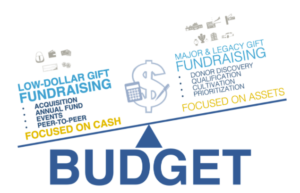
Traditionally, fundraising budgets have been lopsided, with investments focused too heavily on reaching low-dollar donors, even though 67.28% of your revenue is likely coming from just .59% of your donors.
Fundraising automation enables you to do more and do it better, without sacrificing so much of your budget or time. You’ll see how in a bit.
The decline of low-dollar donors
Economy up, donors down.
According to the Fundraising Effectiveness Project, in 2019 the number of overall donors declined by 5.7% and there was a decrease in new donors of 6.4%. That far surpasses Blackbaud’s donorCentrics reporting, which found 25.1% fewer donors over 10 years (an average decline of 2.51% per year from 2005-2015). Donors are disappearing, and the rate of donor defection is increasing.
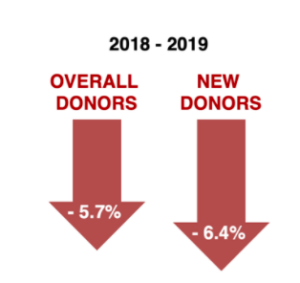
Fundraising Effectiveness Project
Keep in mind this was all happening while the economy was doing great, well before Covid.
That sounds pretty bad. And it is.
However, before we get to how fundraising automation can help your nonprofit reverse these trends, there’s another way to look at the data that shows why growth is more than possible, even in this environment of fundraising climate change.
The Fundraising Report Card found that first time donors who gave $5,000 or more were just about twice as likely to give again compared to first time low-dollar donors who gave less than $100.
What does that tell us?
Major donors don’t just give more, they also give again at far greater rates. So, if you can win more major donors to your cause, you will also be much more likely to keep them.
To make it crystal clear how much this matters, let’s compare two sets of donors: those who give less than $100 and those who give over $5,000.
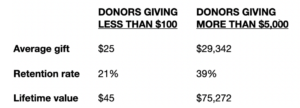
Fundraising Report Card metrics
Add to this the increased costs of fundraising in general, whether that’s social media advertising, printing costs, postage costs (which increased by an average of 6.5% in 2020 alone), telemarketing or events, and you start to see the problem.
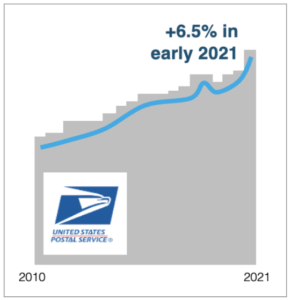
Postage costs continue to increase.
There’s simply no way to make a serious impact on your mission with lopsided fundraising budgets that are too heavily focused on raising money from the low-dollar donor category.
With lower giving amounts, lower retention rates, and lifetime values averaging just $45 per donor, populist fundraising will have to wait. Especially since the tiny group of high-value contributors gives an average of $75,272 over their lifetimes and they become repeat donors at almost twice the rate of low-dollar donors. Plus, sector wide, 82% of legacy gift dollars come from this smaller donor category.
The necessity for change.
Are you doing things the way you’ve always done them? Data like this illustrates massive change in the fundraising climate. If you ignore it, you could be putting your organization’s long-term financial health in serious jeopardy.
Ok, enough doom and gloom!
You CAN thrive in the era of fundraising climate change. I promise. Hundreds of organizations already are.
You CAN fish where the big fish swim too.
Interestingly, what you’ll quickly realize as we get into this is, fundraising automation doesn’t do anything new. It just does what you already know you should be doing, but better.
My next post on this subject.
In the next post I’ll outline the 5 keys to effective marketing. Then I’ll describe how nonprofits like yours usually employ marketing automation but fail to get the most out of the technology.
Spoiler alert! In short, it’s because they only leverage this powerful technology to raise small donations. Yet, the most effective use of automation is for:
- Raising major gifts
- Inspiring legacy gifts
- Helping low-dollar and mid-level donors move themselves up so they make both major and legacy gifts (particularly the people with capacity)
Please go here now: https://imarketsmart.com/how-marketing-automation-helps-nonprofits-raise-more-gifts-at-lower-cost/
Related Posts:
>> Can your nonprofit organization afford to invest in marketing automation?
>> Do you really need MORE gift officers to raise more money?
>>Top 10 ways marketing automation helps nonprofits raise more money for less
>>How to put marketing automation to work for your nonprofit’s fundraising
LIKE THIS BLOG POST? LEAVE YOUR COMMENTS BELOW AND/OR SHARE IT WITH YOUR PEERS!
Get smarter with the SmartIdeas blog
Subscribe to our blog today and get actionable fundraising ideas delivered straight to your inbox!

Great article Greg. You make an important point. I’m talking a lot about a digital-first strategy this year. That doesn’t mean you give up on personal touches. But today’s novel economy requires more. Alas. Things ARE getting harder, so it’s smart to automate where you can. Looking forward to your next articles to see all the ways fundraising automation can help folks!.
Thank you Claire. Much more to come…. I think you’ll like the follow-ups I’ve written. It’s time for major gifts fundraisers to multiply themselves by leveraging technology to reduce costs per dollar raised.
[…] In comparison to donors who received traditional fundraising communications, those who were engaged with an innovative methodology gave +1,119% […]